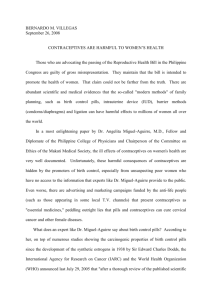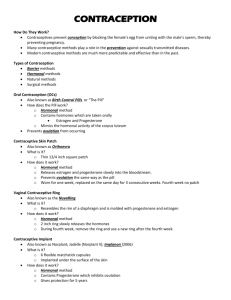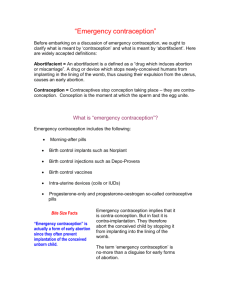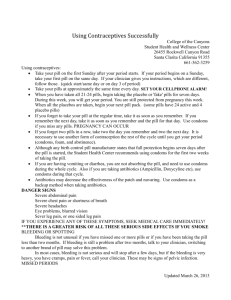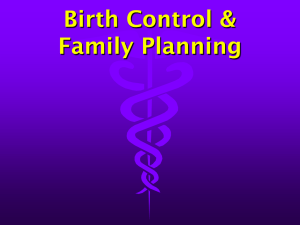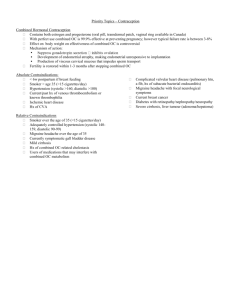Family Planning 101
advertisement
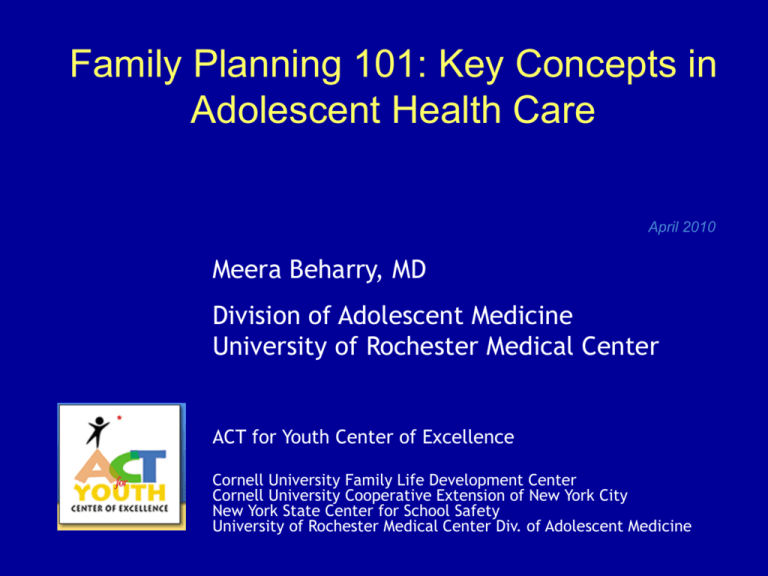
Family Planning 101: Key Concepts in Adolescent Health Care April 2010 Meera Beharry, MD Division of Adolescent Medicine University of Rochester Medical Center ACT for Youth Center of Excellence Cornell University Family Life Development Center Cornell University Cooperative Extension of New York City New York State Center for School Safety University of Rochester Medical Center Div. of Adolescent Medicine Objectives • Define family planning • Describe methods of contraception • Identify resources for adolescents Family Planning • The use of education and birth control to limit the number of offspring and the population of a country. American Heritage® New Dictionary of Cultural Literacy, 3rdEd, 2005 by Houghton Mifflin Company Legal Issues • Distributing information and counseling patients about contraception was illegal under federal and state laws. AP Margaret Sanger, 1914 US fertility rates: 1917-1997 and Key Family Planning Events Title X established Timing of ovulation established Birth Control Pills, IUD approved by FDA MMWR, Dec 03, 1999 48(47);1073-1080 Myriad of Methods Ring Patch Condoms Implant Cap Diaphragm Spermicides Abstinence Injection (“shot”) IUD Pills How do you choose? Decision 1 Hormonal, Non-hormonal or both? Non-Hormonal/Barrier • Condoms Condoms Non-Hormonal/Barrier • Condoms • Diaphragm • Cervical Cap Spermicide Diaphragm Cervical Cap Spermicides Non-Hormonal/Barrier • • • • Condoms Diaphragm Cervical Cap Copper IUD Non-Hormonal/Barrier • • • • • • • • Condoms Diaphragm Cervical Cap Spermicide Copper IUD Abstinence1 Period abstinence/fertility awareness1 “Withdrawal”, coitus interruptus 1 Society for Adolescent Med., J Adolesc Health 2006;38:83–87 Hormonal • Pill – Daily – Emergency (not recommended as a regular form of birth control) Hormonal • Pill • Patch Patch Hormonal • Pill • Patch • Injection Hormonal • • • • Pill Patch Injection Ring Hormonal • • • • • Pill Patch Injection Ring Progesterone IUD IUD Hormonal • • • • • • Pill Patch Injection Ring Progesterone IUD Implantable device Advantages/Disadvantages Non-Hormonal/Barrier Advantages • No hormones • Fewer or no medical contraindications* • Can prevent STD Disadvantages • Event based use • Some need a doctor’s visit Hormonal Advantages • Not event dependent • Additional health benefits – – – – Menstrual symptoms Acne Lower cancer risk Less blood loss Disadvantages • Require use as prescribed • Some medical contraindications Quick Quiz Does a young woman need to have a pelvic exam before starting birth control? NO! Decision 2: if hormonal method Any contraindications? W.H.O. Absolute Contraindications to Estrogen Containing Products • • • • • • Blood clotting problems Stroke Very high blood pressure Some cancers Some liver diseases Major surgery with prolonger immobilization • Migraine headaches with aura http://whqlibdoc.who.int/hq/2008/WHO_RHR_08.19_eng.pdf Decision 3: if hormonal method, How often do you take it? How Often Do You Take It? Method Pills Frequency Every day How Often Do You Take It? Method Frequency Pills Every day Patch Once a week How Often Do You Take It? Method Frequency Pills Every day Patch Once a week Ring Once a month How Often Do You Take It? Method Frequency Pills Every day Patch Once a week Ring Once a month Injection Every 3 months* How Often Do You Take It? Method Frequency Pills Every day Patch Once a week Ring Once a month Injection Every 3 months* Implant (Implanon®) Every 3 years* How Often Do You Take It? Method Frequency Pills Every day Patch Once a week Ring Once a month Injection Every 3 months* Implant Every 3 years* IUD Every 5 years* Quick Quiz: Match the method Match the Frequency & the Method Frequency Match Columns Method a) Once a month 1-Implant b) Once a week 2-Injection c) Daily d) Every 3 months 3-IUD 4-Patch e) Every 5 years 5-Pills f) Every 3 years 6-Ring Match the Frequency & the Method Frequency Correct Answer Method a) Once a month a-6 1-Implant b) Once a week b-4 2-Injection c) Daily c-5 3-IUD d) Every 3 months d-2 4-Patch e) Every 5 years e-3 5-Pills f) Every 3 years f-1 6-Ring Emergency Contraception What if…. …the condom broke or slipped off... …you forgot your regular birth control... …you were forced to have sex... Association of Reproductive Health Professionals Emergency Contraception • What is it? – A method for preventing implantation – A method for preventing fertilization • There are three types available in the U.S. EC Available in the United States Combined Pills Progestin-only Pills Copper-T IUD Dedicated Product: ® Plan B Trussell J, Raymond EG. 2007. Association of Reproductive Health Professionals Emergency Contraception Pills • What they are not: – They are not the “abortion pill” – They are not a form of family planning Resources • Internet: – http://youngwomenshealth.org/ – www.plannedparenthood.org – http://ec.princeton.edu/ • Current health care provider – www.adolescenthealth.org • Family Planning Benefit Program – www.nyhealth.gov/community/pregnancy/family _planning/program_sites.htm ACT for Youth Center of Excellence Was this presentation useful? Please give us your feedback: http://www.zoomerang.com/Survey/WEB22AEZWMYJH3 The ACT for Youth Center of Excellence connects positive youth development resources and research to practice in New York State and beyond. The Center provides: Technical support, training, and evaluation for youth-serving programs funded by the NYS Department of Health. Youth Development resources: www.actforyouth.net, publications, training and events, and the e-letter ACT for Youth Update. Email act4youth@cornell.edu to subscribe. A home base for the ACT Youth Network. Visit the network at www.nysyouth.net act4youth@cornell.edu • 607-255-7736 • http://www.actforyouth.net
